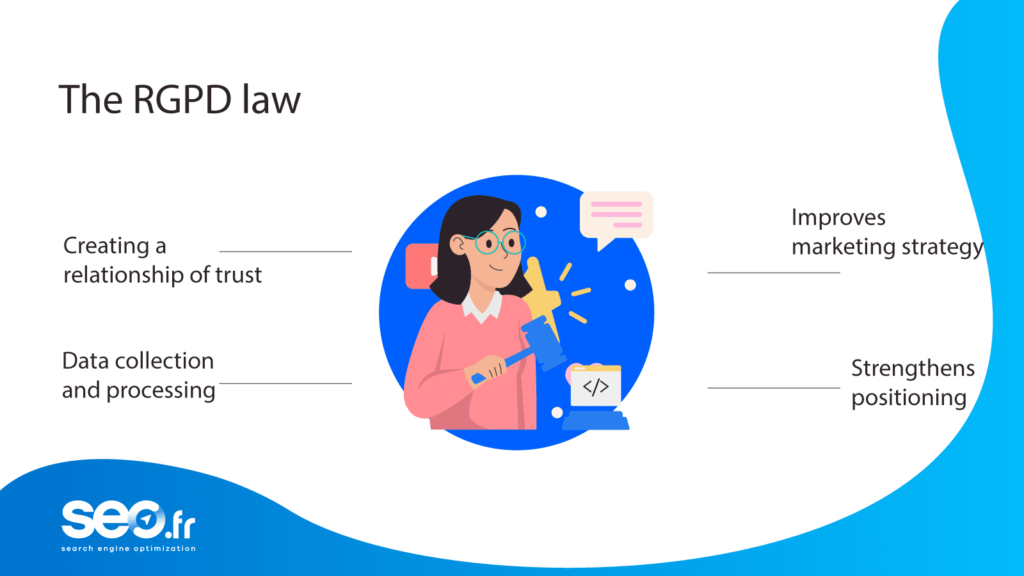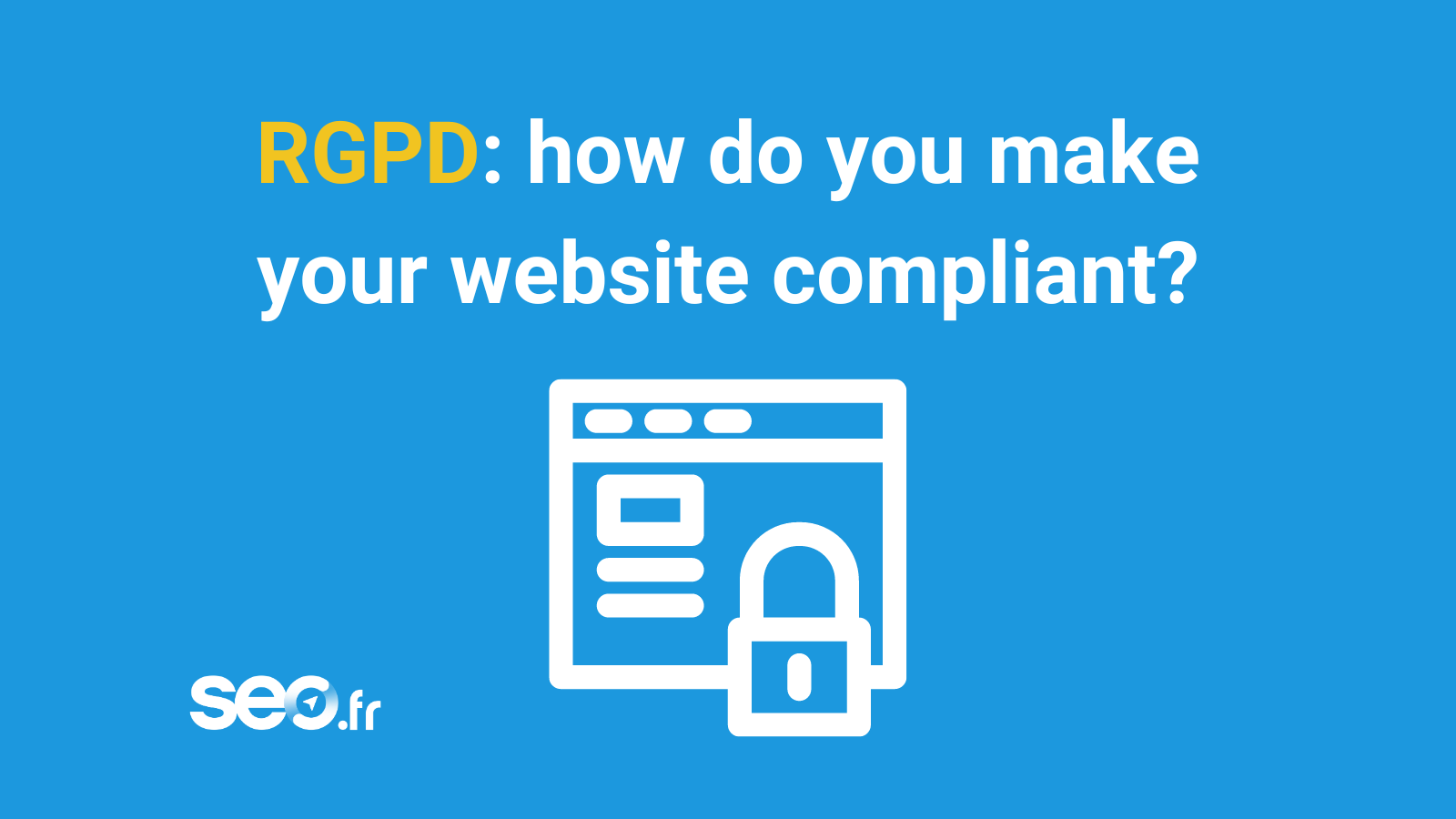You’ve probably already experienced this scene on the web, where you visit a site and the famous cookies appear. The site you are visiting asks for your consent to collect and process your personal data. You realize that data protection is guaranteed. Then, with one click, you give your consent. These are the necessary security measures provided for by the RGPD.
The protection of privacy and personal data on the Internet is now an imperative. Since the entry into force of the new European Data Protection Regulation, RGPD compliance has become a necessity. All companies that collect and store personal data on European Union citizens are being made accountable. This legal framework requires appropriate security measures for the collection of personal information. It creates a legal framework for data processing. Why does your website need to comply with the General Data Protection Regulation?
Being RGPD compliant can optimize your brand’s e-reputation, strengthen your market positioning and improve your marketing strategy. But failure to comply with this new regulation exposes you to a number of risks, including financial penalties. It can also reduce traffic to your website.
Would you like to benefit from your subscribers’ data without infringing the principles established by this European legislation? If so, find out from this content how to bring your site into line with this new regulation.
What is the RGPD law? What you need to bear in mind
The RGPD is an abbreviation of the “General Data Protection Regulation” and concerns the processing of personal data. This law emphasizes respect for privacy and greater accountability on the part of stakeholders and subcontractors (IT service providers). It concerns the data of European citizens and is aimed in particular at private and public companies and institutions that collect and store personal data on the Internet.
The GDPR applies to the whole of Europe. If your company operates in this territory or if you collect and process the data of European citizens, you must comply with this new regulation.
Today, with the new regulation, the level of protection is evolving. The rights of European citizens have been strengthened. In particular, this law defends these six fundamental rights:
- The right to information: stipulates that all citizens must be informed of the processing of their personal data, regardless of the case or situation.
- The right of access: authorizes everyone to exercise their right of access to the data collected about them. It gives the user the power to prohibit, in certain cases, the use of the data.
- The right of rectification: with this right, users can request rectification of the data collected about them.
- The right to object: this allows users to object to the processing of their data in the event of commercial canvassing or for other legitimate reasons.
- The right to erasure: (the right to be forgotten) through this, the RGPD gives everyone the power to request the deletion of their data.
- The right to data portability: authorizes every citizen to request the transfer of data in a machine-readable format.

What are the key stages in complying with this law?
There are several key stages in the process of complying with the new European regulations. Find out about the 7 key steps you need to take to comply:
- Appointing a data protection officer (DPO) in French
Whether internal or external, the compliance officer is responsible for ensuring compliance with the RGPD. They map out the processing operations, prioritize the actions to be taken and manage the risks. The Data Protection Officer is also responsible for organizing internal procedures and RGPD compliance documentation.
- Gather existing documents on the Commission nationale de l’informatique et des libertés (CNIL) website
The CNIL website lists all the formalities you need to complete to comply with the GDPR. All you need to do is consult its site to understand the actions to be taken within your organization. You can also access files of declarations made to this commission. This will give you an initial outline of the activities carried out by your company. What documents do I need to collect? You need to collect, among other things
- Privacy policy ;
- General Terms and Conditions ;
- CGU ;
- Legal notices, etc.
After this phase, draw up an organizational chart of your company, listing the services or departments available and the interactions between them.
- Create a register of processing operations on the basis of documents obtained from the CNIL
The GDPR requires a data processing document. This will be used to list all your files. This register provides an overview of all the data processing carried out by an entity. At this stage in the process of adapting to the new European regulation, you need to list the activities that require your organization to collect data. At this stage of the RGPD compliance process, you can take several activities into account. To put it simply, in the register, list each activity and specify the purpose for which you are collecting personal information. Give a clear idea of who will have access to the data. And above all, provide information on how long the data collected will be kept.
- Analyze company processes
Carry out two audits at this stage of the compliance process. First, carry out a lawfulness study. Through this analysis, you determine whether the purposes comply with the principles established by the GDPR. The new European data protection regulation is based on the following principles:
- Legality, fairness and transparency.
- Purpose limitation.
- Minimization of data.
- Accuracy.
- Storage limitation.
- Integrity and confidentiality.
- Liability issues.
The second audit is used to analyze the management of data subjects’ rights. It also looks at the management of subcontractors. In practical terms, this involves impact analysis and information system security.
- Correct compliance deviations
The data collected must be sorted at this stage of compliance. This is required by the RGPD’s principle of minimization. Personal information must be adequate, relevant and restricted in relation to the purposes for which it is processed. So get rid of superfluous data, and keep what’s essential to protect yourself from penalties imposed by the CNIL. What actions should you take? Set up a register of processing activities and update it regularly. Create and include compulsory information on forms. Update security measures and raise staff awareness of data protection issues.
- Establish a management procedure
Draw up the essential procedures for complying with the new European regulation. These cover: managing the exercise of rights, data protection and measures in the event of a personal data breach. They also cover the measures to be taken in the event of the processing of personal data, the management of impact analyses, the attitude to adopt in the event of a CNIL inspection and the procedure for choosing subcontractors. Above all, the process of adapting to the new European regulation requires regular audits of the mandatory procedures. Finally, update your procedures.
- Pass on information about your site
Explicitly talk to Internet users about data collection. Inform them of their right to access their data. They can refuse or agree to provide their personal information.
Got an SEO question?
Géraldine can help
5 years of SEO expertise

Mistakes to avoid at all costs on your website
There are certain pitfalls in complying with data protection policy legislation. As you might expect. Everyone would be in order if all they had to do was install cookies on a site. So what are the mistakes to avoid when it comes to RGPD compliance?
- Non-updated GDPR documentation
- The cookie banner does not comply with the user typology
- Incorrect setting of your cookie banner
- Neglecting user tracking tools
- Omission of accessibility
- Neglecting the list of cookies available on your sites
- Forgetting to put your RGPD documentation online
RGPD compliance: what are the benefits for your company?
First of all, compliance with the new European regulation means that you can adopt appropriate security measures. This legislation requires all companies to take technical and organizational measures to guarantee the protection of personal data.
Secondly, it is a vector of trust and transparency between consumers and your company. Thanks to the RGPD, your brand can create a relationship of trust with its customers. How can it do this? With this new regulation, you can prove to users that their personal data and rights are guaranteed. This will make it easier for you to build consumer loyalty and attract new customers.
Applying the new European legislation improves your marketing strategy. It puts you in touch with qualified prospects. If you use emailing for your online activities, you will have access to the contacts of people who have given their consent.
What are the consequences of non-compliance?
When we talk about the risks of non-compliance with the new European regulation, we think directly of financial penalties. What about the natural referencing of your website? Does it affect your SERP positioning? The RGPD can have an impact on your website’s SEO. Many sites find that their traffic drops when they check their statistics on Google Search Console. It is sometimes more reassuring to use an SEO agency to manage this technical aspect.
Surprised by this, SEO consultants are analyzing the direct implications of the new regulation. It turns out that user non-consent has something to do with it. When users do not give their consent to the collection of their personal information, this prevents the analytical tag from being activated, so the data is not retained.
However, it should be noted that the new European regulations do not have a significant impact on natural referencing. Why not? Google’s algorithms do not focus on a site’s RGPD compliance. It is not a factor in search engine ranking. Instead, Google looks at the quality of content, the user experience and the loading time of your site. It prioritizes net linking, internal and external linking, your e-reputation and many other key factors.









